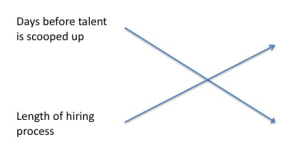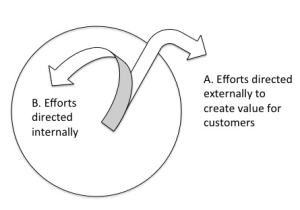There are 5.4 million job openings in the US right now. The unemployment rate is 5.3%, the lowest it has been since April 2008. That means competition for top talent is extremely high.

Meanwhile, the average hiring process has increased by 10 days in the last 5 years. 10 business days! Two weeks! And that’s the average! That means some have gained far more than two weeks.
If you are one of the companies with a slower hiring process, you probably “improved” your process by seeking more input, ensuring a consistent experience for all candidates, testing for anything from drugs to knowledge, documenting your decision more carefully. etc. And you may also have reduced the risk of a law suit from very small to tiny.
But 10 days! With competition for talent at what’s probably an all time high, you can not afford to be slow! Speed matters!
If your hiring process has gotten slower, I guarantee it is just the tip of the iceberg. What else is slower?
- Have you “improved” other processes?
- Have rules replaced judgment?
- Have your activities become so far removed from their purpose that people can’t make smart decisions?
- Are you being consistent for the sake of consistency?
- Are meetings and email consuming a significant percentage of your time?
- Are your processes “more sophisticated” but laden with extra steps, signatures, documentation, too many participants, and protections against rare occurrences?
- Are you dotting too many “i”s and crossing too many “t”s?

The vast majority of your company’s time and energy must be focused externally on creating value for which customers are willing to pay. These are the A efforts in the diagram. The B efforts are directed internally. They include everything from overly onerous processes to circuitous confusion to low priority distractions. When time spent on B efforts goes up, time spent on A efforts goes down. What percentage of time are employees in your company directing toward each?
To correct the imbalance and devote more energy toward value for which customers are willing to pay, you need to:
- Clarify objectives, roles, and responsibilities so the right people can make smart decisions
- Eliminate unnecessary tasks and distractions from those objectives
- Ensure tasks are accomplished with good judgment and only the necessary people
Use this exercise to uncover the best opportunities for improvement:
Imagine creating a customer invoice that includes all the activities in your company. Every single one! Not just the items purchased. Now imagine giving that invoice to your best customers.
All the activities on the invoice would fall in three categories:
- Tasks that create value for which customers would gladly pay. These tasks are all externally focused. Put these activities on the invoice and you will hear nary a squeal. Examples include:
- Building, painting, shipping their product
- Anything directly responsible for the value your customers receive
- Tasks customers would acknowledge as essential and would be willing to contribute toward as long as it is in reasonable proportion to the value they receive:
- Acquiring the talent needed to produce great products
- Issuing paychecks
- Letting them and other customers know about your products
- Developing future products and services
- Maintaining facilities and equipment
- Tasks that would freak out customers if you asked them to pay and leave you feeling totally embarrassed. The list of potential category 3 items is huge. Here are a few examples:
- Chasing signatures of managers who barely look to see what they are signing
- Shuffling offices, titles, org charts, and paperwork
- Rework
- Gathering performance review input that flatters or skirts the issues and improves no one’s performance
- Including nearly everyone in meetings “just in case” and accomplishing very little
If the thought of explicitly asking a customer to foot the bill for all these activities makes you cringe, you need to stop doing them! Eliminate the activities in the third category, minimize those in the second, and deliver the first promptly and profitably.


Comments are closed.